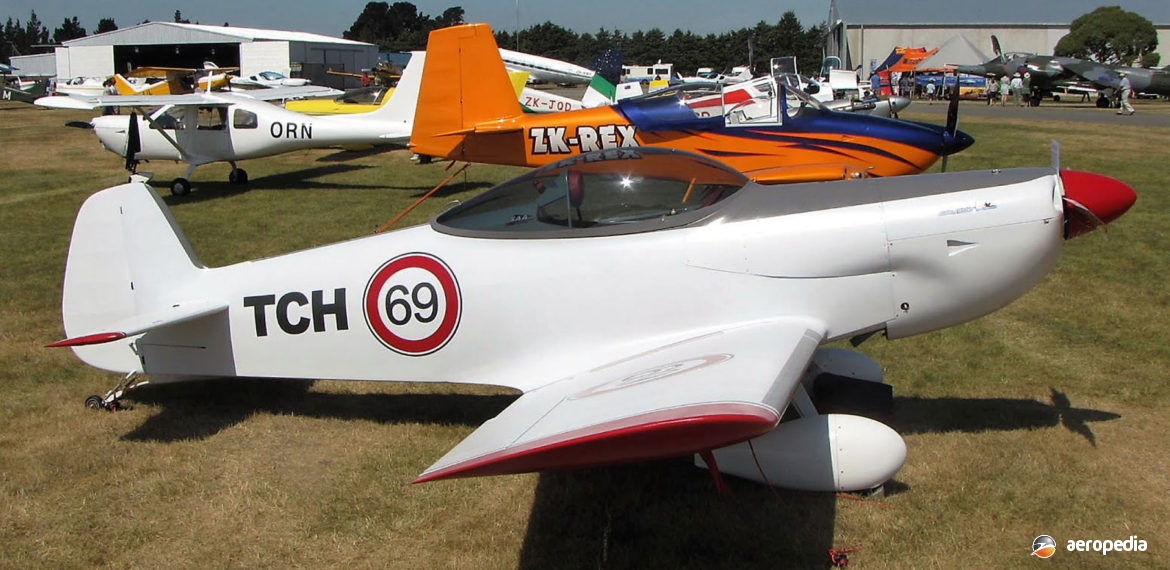Photograph:
Taylor JT-2 Titch ZK-TCH (c/n AACA 210-1) at Ashburton, New Zealand in February 2013 (Keith Morris – NZCIVAIR)
Country of origin:
United Kingdom
Description:
Single-seat light sport monoplane
Power Plant:
One 63 kw (85 hp) Continental C-85 four-cylinder horizontally-opposed air-cooled engine
Specifications:
- Wingspan: 5.72 m (18 ft 9 in)
- Length: 4.91 m (16 ft 1½ in)
- Height: 1.42 m (4 ft 8 in)
- Wing area: 6.32 m² (68 sq ft)
- Max speed: 274 km/h (170 mph)
- Cruising speed: 250 km/h (155 mph)
- Max rate of climb at sea level: 335 m/min (1,200 ft/min)
- Stalling speed: 85 km/h (53 mph)
- Range: 611 km (380 miles)
- Empty weight: 227 kg (500 lb)
- Loaded weight: 338 kg (745 lb)
History:
The Taylor Titch, like the Taylor Monoplane, was designed by the late Mr John Taylor in the United Kingdom and was designed to improve on the basic design of the JT-1 but not to replace that aircraft as the aerodynamic characteristics of the two were quite different. Construction of the prototype began in February 1965, and the first flight was made on 22 January 1967. The design had previously been entered in the Midget Racer Design Competition organised by the Rollason Company in 1964, where it won second prize. On 16 May 1967 the prototype crashed, killing the designer. However, plans became available and a number have been built around the world, including New Zealand. Some 35 are known to have been completed.
The wing of the Titch was constructed of wood, with plywood and fabric covering. The fuselage was also of wooden construction, plywood covered, with aluminium around the cockpit. The tail was also wood. The fixed surfaces were plywood covered and the control surfaces were fabric covered. A non-retractable tailwheel type undercarriage was fitted. Engines in the 30 kw to 71 kw (40 hp to 95 hp) range could be installed. It was fully aerobatic and a number of constructors modified the design in the United States to meet their own requirements. One, based in Kansas City, Missouri (N14J) was fitted with a Continental C85-12F engine, a three-blade propeller, and had a max speed of 322 km/h (200 mph) at 610 m (2,000 ft).
Examples issued with registrations, or having had them reserved, included: ZK-DBH (c/n AACA-91) which was built at Kawerau but was not officially registered, although photographic evidence indicates it was completed. It was flown and was damaged in an accident at Kawerau on 8 September 1972. The wreck was later sold but is not known to have been rebuilt.
ZK-DFK (c/n AACA-112) was built at Mt Maunganui and was first registered on 1 April 1973. This machine had a Revmaster engine of 2100 cc capacity. It crashed at an airshow at Whitianga on 1 December 1973 and was destroyed.
ZK-DNH (/n AACA/194-1) was registered to its owner at Christchurch but was not completed and the registration was cancelled on 2 March 1994.
ZK-DGB (c/n AACA/113/1) was built at Greenmeadows in the Hawkes Bay area and was fitted with a 1600 cc converted Volkswagen engine. It also was lost in an accident on 25 March 1979 when it suffered an engine failure on take-off.
Another had the registration ZK-DYF (c/n AACA 210-1) reserved to its owner at Blenheim, work on the aircraft beginning in the 1970s, but it was not completed. It was sold and late in 2011, on 4 August, it became ZK-TCH. It was powered by a 60 kw (80 hp) Jabiru 2200A engine.
A further example arrived in New Zealand in early 2011, this aircraft being imported from the United Kingdom, becoming ZK-RMC (c/n PFA 060 10725 – ex G-MOLE), being registered on 28 April in Wellington.
Another example has been registered in Australia under RAA regulations as 19-7943 (c/n JOH-3 – ex C-FXYA).

